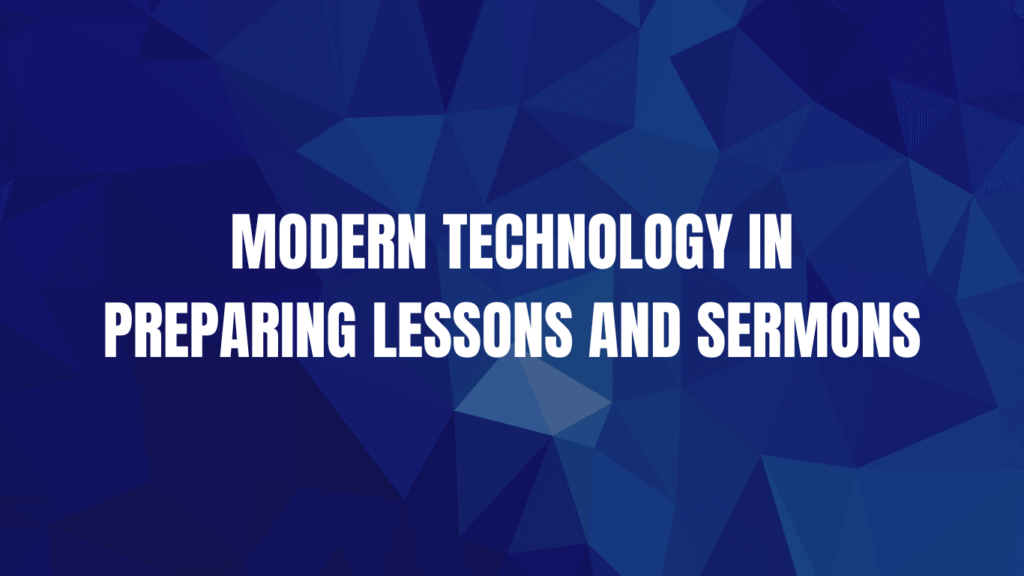Written by Yeow Chin Kiong
Preparing Bible lessons and sermons is not difficult because it only requires the proper handling of information readily available from merely one source, God’s word (2 Timothy 2:15; 4:2), and effectively communicating it to others to save them from the consequence of their sin and guide them to do good works to remain saved (2 Timothy 3:14-17).
All that is needed for preaching or teaching God’s word in any situation is
to gather all that has been Divinely-revealed in the holy scriptures about a particular topic (eg. salvation, the church or marriage) and read those passages,- which are generally self-explanatory,- correctly and clearly to our hearers, perhaps with some explanation of their meaning and application (Nehemiah 8:7-9). Indeed, we are warned not to go beyond God’s revealed word (1 Corinthians 4:6-7). Teachers are cautioned to use their tongue with care because they will be held accountable for what they communicate (James 3:1-12).
The church is “the pillar and ground of the truth” (1 Timothy 3:15) and the message of sermons from her pulpits and Bible lessons from her podiums must be truthful. Christians are commanded to “Test all things; hold fast what is good. Abstain from every form of evil” (1 Thessalonians 5:21-22). The main problem related to the preparation of both types of messages experienced by Christians even a mere couple of generations ago was lack of resources, including easily understandable Bible versions and translations of the Bible. Today, in our age of Information Technology, the situation has swung to the other end of the penddulum; there is sheer excess of Bible versions and translations and Bible study helps readily and cheaply available, which lulls us into blindly and unreservedly accepting everything we receive from online sources as correct and truthful.
Even prior to our present age of generative Artificial Intelligence (AI) and Large Language Model-based (LLM) information sources, the challenge to preachers and Bible teachers was to be judicious and discerning in using Bibles and Bible study helps in their sermon and lesson preparation. Using AI-derived sources of seemingly settled facts and opinions require more caution in terms of information-checking.
LLMs behind today’s AI tools do not “understand” anything and are simply not designed to verify the truth of what they are “trained” by reading language-patterns from the massive “learning materials” they are fed with. When AI is asked a question, its response is not based on understanding the semantics (or meaning) of the query. AI merely executes a complex statistical analysis of word usage in the question using the billions of words it was “trained” on. It then reads patterns of your “prompt” words to “generate” what it statiscally computes to be an appropriate word sequence in a predicted response or answer to the prompt. There is no “understanding” in AI, only large scale statistical analysis and word matching. Obviously, too, the reliability and truthfulness of “learning materials” an AI platform is trained on will determine the reliability and truthfulness of its response to human prompts. Remember the adage, “Garbage in, garbage out”?
When Wikipedia (“the free encyclopedia”) appeared on the internet in 2001, few could imagine the massive source of readily-available “updateable” and almost real-time information it would become to students and teachers worldwide within a couple of years. But, then, you can still fact-check Wikipedia content by following the trail of source-references embedded within Wiki-articles. In contrast, at present, AI’s dependence on “Machine Learning”-generated information output does not guarantee the correctness or truthfulness of its product and, with the appropriate and probing user-prompt, will even generate an honest (and courteous!) admission that elements of its response to an earlier query were “hellucinations” or totally made-up!
The problem for Bible preachers and teachers arises especially when they search for extra-Biblical information to explain or illustrate points made by the scriptures. In scouring for material to embellish a sermon or lesson, or for graphics like photos or video clips to illustrate thoughts conveyed by scripture, they may neglect to practise due diligence by verifying the source and trustworthiness of the AI-acquired material they incorporate in their presentation to ensure their messages are,- above all,- truthful, as is God’s word (John 17:17; Psalm 119:160).
The bottom line is that IT in all its manifestation is a useful tool in many dimensions of human life. To preachers and Bible teachers concerned about communicating God’s truth for the salvation of sinners, it should help make our preparation of pulpit and podium material more effective and efficient, provided they put in the effort to verify the accuracy,- essentially, the correctness or truthfulness,- of the contents of their presentation which have been crafted with the aid of AI. After all, fact-checking was a Christian responsibility for every communication conveyed or received, even as early as in the garden of Eden!
Much more about what God’s word says concerning this topic will be presented by brother Jamie Long during the YEAR-END SEMINAR 2025 to be held from 1.30 pm to 5.30 pm on Saturday, 15 November 2025 at the premises of Klang church of Christ, 11 Jalan Teluk Pulai, 41100 Klang, Selangor. All are encouraged to attend this spiritual feast about contemporary issues on the theme, “Challenges Of The Information Technology Generation.”

